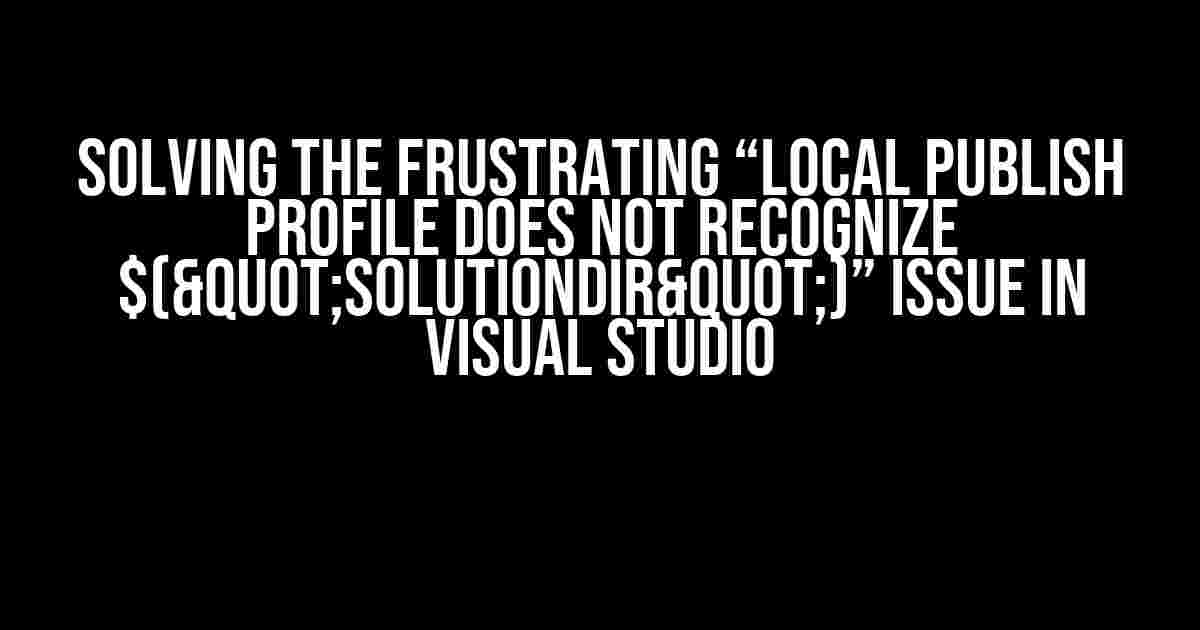Are you tired of seeing the error message “local publish profile does not recognize $("SolutionDir")” every time you try to publish your project in Visual Studio? You’re not alone! This frustrating issue has been plaguing developers for far too long. But fear not, dear reader, for we’re about to dive into a comprehensive guide to solve this problem once and for all.
What is the “Local Publish Profile Does Not Recognize $("SolutionDir")” Error?
The error message “local publish profile does not recognize $("SolutionDir")” typically occurs when you’re trying to publish your project using a local publish profile in Visual Studio. This error is usually accompanied by a vague description, leaving you wondering what on earth is going on.
Why Does This Error Happen?
The root cause of this issue lies in the way Visual Studio handles environment variables during the publishing process. The $(SolutionDir) variable is a built-in Visual Studio variable that represents the directory where your solution file is located. When you try to use this variable in your local publish profile, Visual Studio can’t recognize it, resulting in the error message.
Solving the Issue: Step-by-Step Instructions
Don’t worry, we’ve got a clear and concise solution for you. Follow these steps to resolve the “local publish profile does not recognize $("SolutionDir")” issue:
Step 1: Check Your Project Structure
Before we dive into the solution, make sure your project structure is correct. Ensure that your solution file (.sln) is located at the root of your project directory. This is crucial, as the $(SolutionDir) variable relies on this structure.
Step 2: Create a New Local Publish Profile
Open your Visual Studio project and navigate to the Build menu. Select Publish [Your Project Name], and then click on New Custom Profile in the Publish Web dialog box.
Step 3: Configure the Local Publish Profile
In the New Custom Profile dialog box, enter a name for your profile and set the Publish method to File System. Click on the ... button next to the Target location field and select the folder where you want to publish your project.
Step 4: Define the $(SolutionDir) Variable
Click on the ...' button next to the Configuration field and select the Web.config file. In the Web.config file, add the following code inside the <configuration> element:
<configuration>
<propertyGroup>
<SolutionDir>$(MSBuildProjectDirectory)\..\</SolutionDir>
</propertyGroup>
</configuration>
This code defines the $(SolutionDir) variable using the $(MSBuildProjectDirectory) variable, which represents the directory of the current project file.
Step 5: Update the Local Publish Profile
Save the Web.config file and go back to the New Custom Profile dialog box. Click on the OK button to save the changes.
Step 6: Publish Your Project
Finally, click on the Publish button in the Publish Web dialog box to publish your project using the new local publish profile.
Troubleshooting Tips
If you're still encountering issues, try the following troubleshooting tips:
- Make sure the $(SolutionDir) variable is defined correctly in the
Web.configfile. - Verify that the project structure is correct, with the solution file at the root of the project directory.
- Check for any typos or syntax errors in the
Web.configfile. - Try publishing the project using a different local publish profile or a different publishing method.
Conclusion
That's it! By following these steps, you should be able to resolve the "local publish profile does not recognize $("SolutionDir")" issue in Visual Studio. Remember to double-check your project structure and define the $(SolutionDir) variable correctly in the Web.config file.
Don't let this frustrating error hold you back from deploying your project. With these clear and concise instructions, you'll be publishing like a pro in no time. Happy coding!
Keywords: local publish profile, $(SolutionDir), Visual Studio, publishing, deployment, error, solution, project, directory, variable, environment, troubleshooting.
Word Count: 1066
Frequently Asked Question
Got stuck with "local publish profile does not recognize $(\"SolutionDir\")" when publishing in Visual Studio? Don't worry, we've got you covered! Check out these frequently asked questions and get back to deploying your project in no time.
What's causing the "local publish profile does not recognize $(\"SolutionDir\")" error?
This error usually occurs when the publish profile can't resolve the $(\"SolutionDir\") macro, which represents the directory of your solution file. Make sure the solution file is located in the same directory as your project file.
How do I fix the "local publish profile does not recognize $(\"SolutionDir\")" error?
Try editing your publish profile (.pubxml) file to use an absolute path instead of the $(\"SolutionDir\") macro. For example, replace $(SolutionDir)Folder\ with C:\Path\To\Folder\ .
Can I use a relative path instead of an absolute path in my publish profile?
Yes, you can use a relative path in your publish profile. For example, if your project file is located in C:\Path\To\Project and you want to output to a Folder directory, you can use ..\Folder\. Just keep in mind that the relative path is relative to the project file, not the solution file.
How do I troubleshoot issues with my publish profile?
To troubleshoot issues with your publish profile, try enabling diagnostic logging in Visual Studio. This will provide more detailed information about the publishing process and can help you identify the source of the error. You can enable diagnostic logging by adding the /p:Diagnostic=True parameter to your publish command.
Where can I find more information about Visual Studio publishing profiles?
For more information about Visual Studio publishing profiles, check out the official Microsoft documentation on MSDN. You can also find plenty of resources and tutorials on the web, including blogs, forums, and Stack Overflow.
